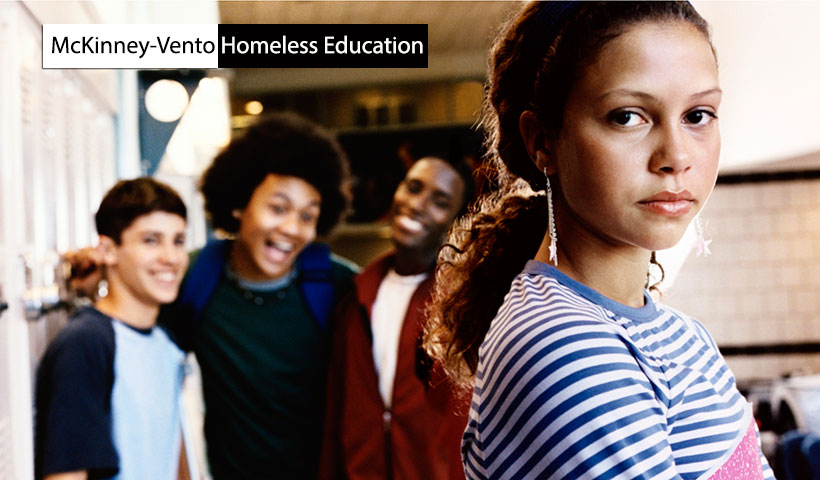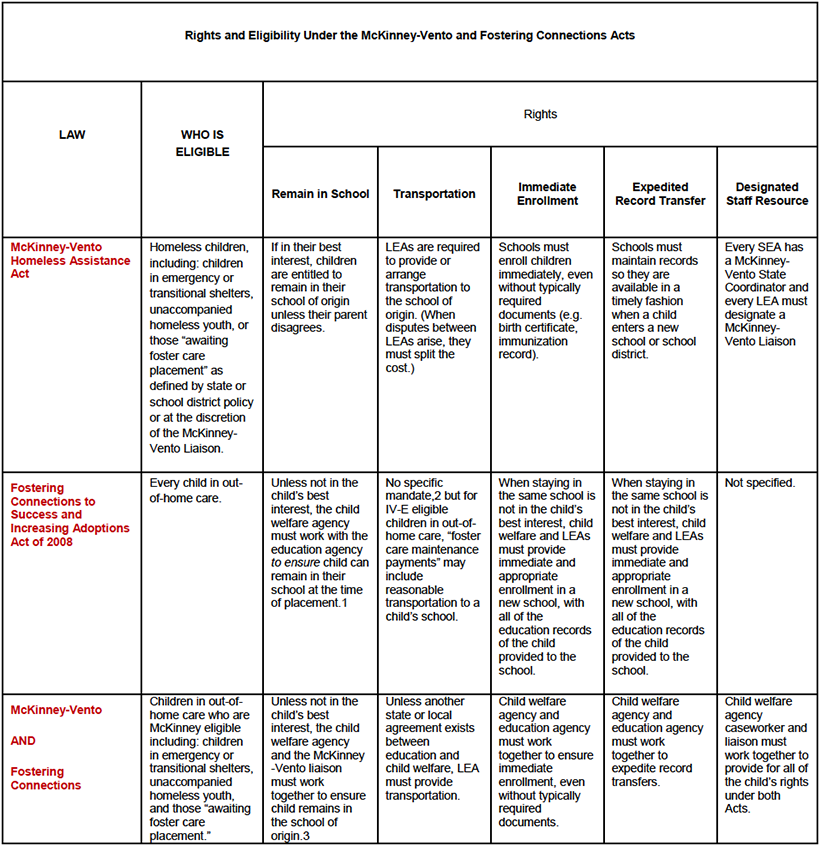

The McKinney-Vento Homeless Assistance Act ensures educational rights and protections for children and youth experiencing homelessness. During the 2011-2012 school year, The School District of Palm Beach County served over 1,450 homeless children and youth.
The Federal McKinney-Vento Homeless Assistance Act states that children and youth who lack a fixed, regular, and adequate nighttime residence are considered homeless. If, due to a loss of housing, a child must live in a shelter, motel, vehicle, campground, on the street, in abandoned buildings, or doubled-up with relatives or friends, then he/she is eligible to receive services provided under the McKinney-Vento Act.
The McKinney-Vento Education for Homeless Children and Youth Program is designed to address the problems that homeless children and teens have faced in enrolling, attending, and succeeding in school. Under this program, state educational agencies must ensure that each homeless child and teens has equal access to the same free, appropriate public education, including a public preschool education, as other children and teens.
Homeless children and teens must have access to the educational and other services that they need to enable them to meet the same challenging state student academic achievement standards to which all students are held. In addition, homeless students may not be separated from the mainstream school environment.
Florida Department of Education
Current education law, the McKinney-Vento Homeless Assistance Act (McKinney-Vento), has been providing education stability for some children in out-of-home care. A relatively new child welfare law, the Fostering Connections to Success and Increasing Adoptions Act (Fostering Connections), now also supports education stability for all children in out-of-home care. Both laws recognize the need for school stability and continuity for these highly mobile children. However, each provides a different set of rights and responsibilities. This fact sheet provides a brief overview of the overlap between the two laws, and the critical importance of collaboration between the education and child welfare systems to appropriately serve the needs of children in out-of-home care.
A: The diagram demonstrates that those children eligible under the McKinney-Vento Act and Fostering Connections Act may overlap. For example, if a child is in out-of-home care and also meets the definition of awaiting foster care placement, both Fostering Connections and McKinney-Vento apply. State laws may also apply. The application of one law does not diminish the rights provided by the others. Rather, each law adds a layer of rights and protections for children, based on their circumstances and needs.

A: Fostering Connections, McKinney-Vento, and other federal and state education and child welfare laws must work together to support students in out-of-home care. Initially, advocates should determine which federal and state laws and policies apply to a particular child. Advocates should then ensure the child receives the protections of all applicable laws.

To ensure proper implementation of federal and state laws for children in out-of-home care, child welfare supervisors, caseworkers, and other advocates should meet with school district McKinney-Vento liaisons, special education directors, and other administrators. Meetings should address topics such as best interest determinations, transportation plans, enrollment protocols and record transfers. Communication and collaboration among education and child welfare professionals are critical to support school success for children in out-of-home care.
A: No. The passage of Fostering Connections, a child welfare law, does not change the rights and protections of McKinney-Vento. Children in out-of-home care may continue to be eligible under McKinney-Vento if they are living in transitional or emergency shelters, are “awaiting foster care placement,” or are unaccompanied homeless youth.
A: The passage of Fostering Connections, a child welfare law, does not change in any way the best interest determination for children who qualify for McKinney-Vento. This decision is still made by the McKinney-Vento liaison. Just as before, best practice suggests that the McKinney-Vento liaison should gather information about a child from the child, foster parent, child’s caseworker and child advocate or attorney in making a best interest determination. While the input of a caseworker is very critical in making a best interest determination under the McKinney-Vento Act, it is only the McKinney-Vento liaison and parent who will ultimately make this decision.
However, when a child in out-of-home care is not eligible for McKinney-Vento, the rights of Fostering Connections still apply. As such, it may be the child welfare agencies’ responsibility to make the best interest determinations. Best practice would suggest that education agency staff should be consulted in making these decisions.
A: Unless a court has limited a parent’s education rights, the parent continues to be the decision maker for all special and general education decisions. This is true under both Fostering Connections and McKinney-Vento.
© Copyright 2010, American Bar Association & Casey Family Programs. All rights reserved.
- default_titleIn a shelter, motel, vehicle or campground
- default_titleOn the street
- default_titleIn an abandoned building, trailer, or other inadequate accommodation, or
- default_titleDoubled up with friends or relatives because they cannot find or afford housing
- Show More
- default_titleImmediate enrollment
- default_titleContinue at the same school if transportation is feasible
- default_titleAttend special programs and services as all other students
- default_titleFor more information… review the Students Experiencing Homelessness Policy (5.74)
- Show More
The Homeless Education Assistance Resource Team is made up of a group of committed social service professionals who work to address problems often faced by homeless children and youth in enrolling, attending, and succeeding in school. Each school in every geographic area of the District is served, as well as family homeless shelters, and state identified “neglected” shelter sites. The team serves homeless children and teens, unaccompanied youth, students awaiting foster care placement, and those “aging-out” of the foster care system.
- default_titleInform parents, guardians, or youth of educational rights
- default_titleLink homeless students with educational and other services, which can include preschool and health services
- default_titleArrange academic tutoring if needed
- default_titleProvide school supplies and if needed, school uniforms
- default_titleCoordinate District’s transportation services to maintain home school stability
- default_titleEnsure Free School Meals (free breakfast and lunch)
- default_titleAttend School Based Team meetings to garner additional student supports
- default_titleProvide outreach services to students living in shelters, motels, and other temporary residences
- default_titleAssist with summer camp and summer enrichment opportunities
- default_titleFacilitate parental involvement specifically oriented to reaching out to parents of homeless students
- default_titleAssist with fees for AP, IB and SAT/ACT testing
- default_titleCollaborate with other district programs and community agencies to meet additional individual needs of homeless children and youth
- Show More
